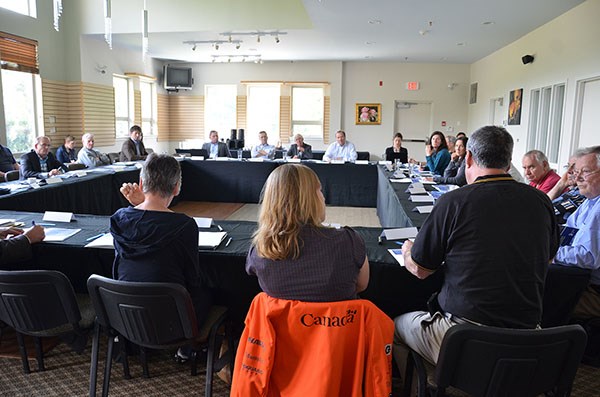Backers of a proposed liquefied natural gas (LNG) export plant along the shores of Howe Sound say they’re willing to change plans to appease Squamish residents and added their track record proves it.
At the first of a string of open houses this week, on Monday (June 16), Woodfibre LNG vice president Byng Giraud outlined three changes to the proposed $1.7 billion project that he said demonstrate the proponents’ commitment to the community.
After public input last February, the facility’s proposed energy source was switched from gas-run turbine drives to electricity. The hydro-run facility is anticipated to produce 80,000 tonnes of carbon dioxide per year, compared to the 450,000 tonnes generated by a gas-powered plant, Giraud noted.
To minimize noise pollution and vibration impacts on marine life, the natural gas liquefaction plant was moved from floats offshore to a facility onshore, he added. The plant will also use water cooling to remove heat from equipment, rather than air cooling, another alternation that cuts down on noise pollution, Giraud said.
The water cooling system collects 17,000 cubic metres of seawater per hour from an intake pipe 25 metres below Howe Sound. After absorbing the heat from the equipment through a closed circuit, in which seawater doesn’t come into direct contact with the liquefaction refrigerants, the water re-enters the ocean through an outlet 25 metres deep, Woodfibre LNG president Anthony Gelotti said.
Building the liquefaction plant onshore rather than offshore will add 200 jobs per year during the construction phase, Giraud added. Proponents estimate 500 people annually will be needed over the anticipated two-year building period. Once up and running, the 24/7 facility will employ 100 people in three to four shifts.
“Our intent is to hire local as much as possible,” Giraud said.
Not everyone at the open house was impressed by the project’s proposed changes. Tracey Saxby, co-founder of My Sea to Sky — an organization raising concerns regarding LNG — questioned how proponents can say they’re running the plant off electricity before studying its feasibility. The company is doing a study with B.C. Hydro, Woodfibre project director Alex Brigden replied.
“We know that for our normal operation that the power that can be supplied is sufficient,” he said, noting that equals to 140 megawatts of power.
The two parties are examining peak loads. If those prove too much for the grid, the plant could scale back operations, Brigden noted.
Saxby asked proponents for information on the use of gas flares. Flare stacks are a gas combustion device employed to burn off gas released by pressure relief valves during un-planned over-pressuring of plant equipment or planned plant start-ups and shutdowns.
The plant will be running 97 per cent of the time, Brigden said. During the three per cent of its operation scheduled for maintenance, there is a slight possibility of flaring, he said. Current drafts show the flare stack as 115 metres tall.
“It is in our interest to try and reduce the size of the flare,” Brigden said.
Squamish resident Mohammad Afsar wanted to know how much tax revenue the plant would generate for the District of Squamish. That rate will be based on the construction costs, which is submitted to B.C. Assessment, Giraud replied. B.C. Assessment determines the project’s value, which in turn is handed to the municipality, where staff apply the district’s mill rate.
The district’s mill rate is set at $27,500 per $1 million in valuation, Coun. Doug Race said. If Woodfibre was assessed at one-seventeenth of the estimated cost to build it, the municipality can expect to collect $2.7 million in taxes, he said.
Until July 11, the province’s Environmental Assessment Office is receiving public comments about the project.
Public input can be submitted at www.ceaa-acee.gc.ca.



